| Covered Bridges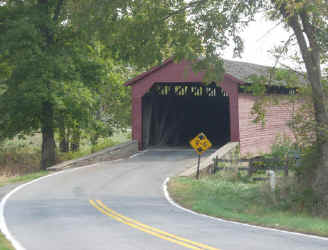 In addition to being a literal "crossroads of history and transportation routes," Frederick County is home to a variety of historic water crossroads and crossings, many of which can be found on the National Register of Historic Places. The traveler will find bridges of various size and architectural design, constructed of wood, stone, iron and steel. Frederick County is fortunate to have three active historic covered bridges. The southern most is the Utica Mills Covered Bridge, located on Utica Road (off of Old Frederick Rd). The original Utica Mills Covered Bridge was built around 1850 and is located on Utica Road off of Old Frederick Road over Fishing Creek. The bridge originally spanned the nearby Monocacy River but was washed away during a severe storm in 1889. Local citizens gathered the remains and reconstructed the 101-foot long Burr arch truss bridge at its present location crossing Fishing Creek. Loy's Station Covered Bridge is an original Howe truss bridge built around 1848 and is located on Old Frederick Road, south of Rt. 77, east of Thurmont. The Loy's Station Bridge is a picturesque, barn-red, one-lane covered bridge that also spans Owens Creek. The bridge's design utilizes multiple king post trusses covered with beveled clapboard, and was rebuilt after an arsonist's fire nearly destroyed it in 1991. The bridge is 90 feet in length and 12.2 feet high. 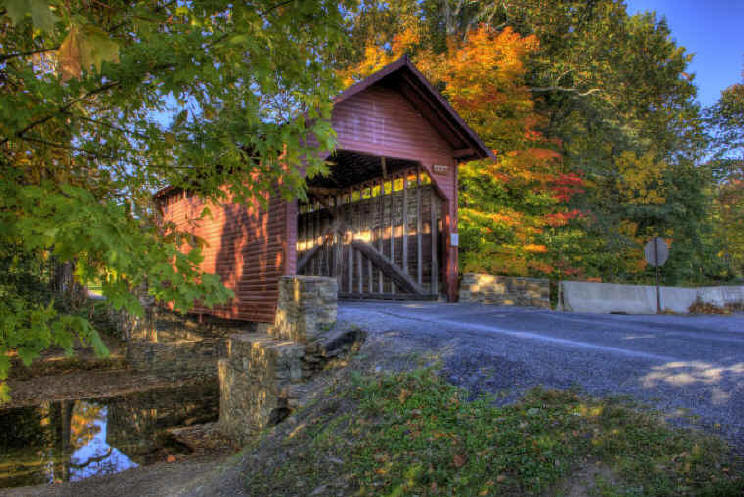
Roddy Road Covered Bridge is located just north of Thurmont, the Roddy Road Covered Bridge was built in 1856. The single-span bridge over Owens Creek can be found just east of US 15 where Roddy Creek Road intersects with Roddy Road. The smallest of the county's covered bridges, this structure features a King Post design and measures 45 feet in length. Gateway Crossings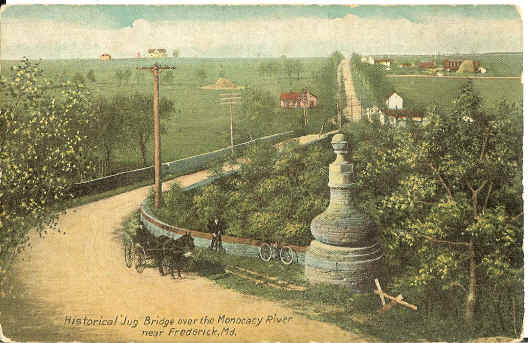 Built in 1808, a very unique stone arch bridge once carried covered wagons, passenger carriages, Civil War troops, horse and buggy and automobiles over the Monocacy River just east of Frederick (RT 144). To travelers coming from the east on the famed National Pike, the bridge, named Jug Bridge represented a gateway to Frederick, welcoming tourist and teamster alike. One such visitor was the Revolutionary War hero Marquis de Lafayette, who was met at Jug Bridge in 1823 by a distinguished local welcoming committee. The name Jug Bridge was derived from a jug-shaped stone demijohn, formerly located on the structure's eastern approach. The bridge consisted of two 65-foot spans that were carried over five arches. After 130 years of heavy use, Jug Bridge suddenly collapsed into the river below on March 3, 1942. Although the original abutments still exist, a new modern bridge was built as a replacement. In 1965, the iconic "jug" and a stone monument to Lafayette were moved a few miles west of their original location. Nearly 200 years after the building of the famed Jug Bridge, a "gateway of bridges" of varying styles welcome travelers and tourists alike to Downtown Frederick, within the newly constructed Carroll Creek Park area. Other major gateway bridges, to and from Frederick County, are located along the Monocacy River and Carroll County on the east. From Virginia, three major spans over the Potomac River occur at Point of Rocks (US 15), Brunswick (MD 17) and Sandy Hook (US 340) on the south and southwest border of Frederick County. Business Bridges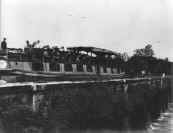 Southeast of Point of Rocks (MD 28) at the confluence of the Monocacy and Potomac rivers is the aptly named Monocacy Aqueduct, the largest of the Chesapeake & Ohio Canal's 11 aqueducts. Described by historians as one of the finest canal structures in the nation, the Monocacy Aqueduct is constructed primarily of large granite blocks that came from nearby Sugarloaf Mountain. Visitors can walk across the dry aqueduct channel, which once ferried canal boats across the river for nearly a century. To the west on (MD 464) you'll find the minute village of Lander, located within the heart of the C & O National Park. Here is the site of the Catoctin Aqueduct, the second such structure of its kind located along Frederick County's portion of the famed 184-mile long canal. West of Woodsboro, construction began on the LeGore Bridge in 1998 by local businessman James William LeGore. Legore utilized limestone and workman from his own business endeavor, the LeGore Quarry, to build the five-arched, 340 foot-long structure. Spanning the Monocacy River, some sixty feet above, this passage was originally built to aid the transport of LeGore's quarried products. Iron and Steel 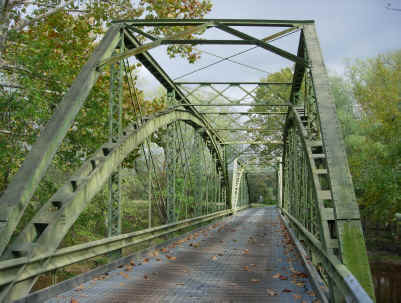 The bridge industry in America flourished in the late 1800's, producing a host of companies involved in the trade. To facilitate transportation growth, and combat the strength of flood waters, the Frederick County Commissioners were eager to hire outside firms in Ohio, New York and Pennsylvania to replace existing wooden bridges in favor of iron and steel truss bridges. The bridge industry in America flourished in the late 1800's, producing a host of companies involved in the trade. To facilitate transportation growth, and combat the strength of flood waters, the Frederick County Commissioners were eager to hire outside firms in Ohio, New York and Pennsylvania to replace existing wooden bridges in favor of iron and steel truss bridges.
Many of these still remain today and are found scattered throughout the county. Mumma Ford bridge over the Monocacy River is pictured to the right. Erected in 1911, this water crossing was constructed by the York Bridge Company of York, Pennsylvania. Another prime example of this group is the Toms Creek Bridge, located southeast of Emmitsburg, which takes the Four Points-Keysville Road over Tom's Creek. This crossing was built in 1876 and is a steel pin connected truss bridge. A subtype of the popular Pratt truss, the half-hip conserved material by eliminating some vertical members. The 103-foot-long bridge is one of many in the state designed and built by the prolific Wrought Iron Bridge Company of Canton, Ohio, one of the largest manufacturers of iron truss bridges in the nineteenth century. In its heyday, the company employed 270 men and had projects in twenty-five states. Tom's Creek Bridge's ornate nameplates and decorative portals are reminiscent of those of the 1878 Poffenberger Road Bridge crossing Catoctin Creek west of Jefferson, which may have been built by the same company. Learn more with Frederick County Government's Historic Bridge Survey |